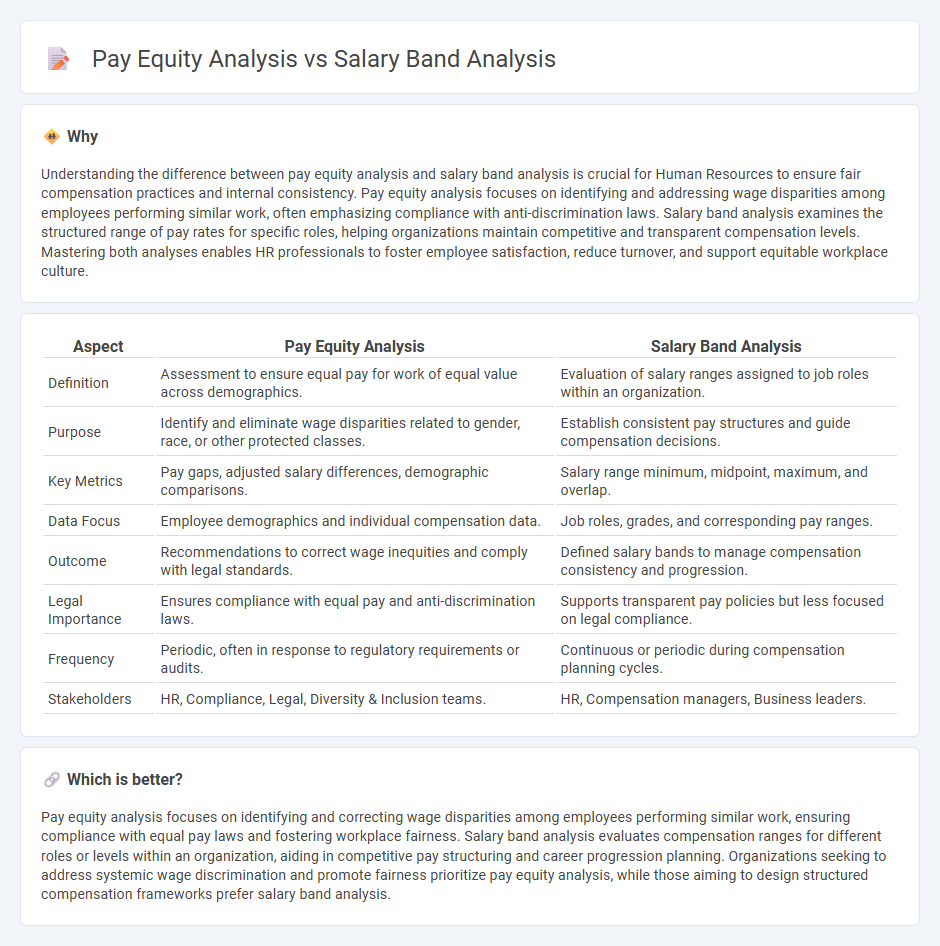
Pay equity analysis evaluates compensation fairness across gender, race, and other demographic factors to ensure compliance with legal standards and promote workplace diversity. Salary band analysis focuses on structuring pay ranges for roles based on market data, job responsibilities, and organizational hierarchy to maintain competitive and consistent salaries. Explore the key differences and benefits of these analyses to enhance your HR compensation strategy.
Why it is important
Understanding the difference between pay equity analysis and salary band analysis is crucial for Human Resources to ensure fair compensation practices and internal consistency. Pay equity analysis focuses on identifying and addressing wage disparities among employees performing similar work, often emphasizing compliance with anti-discrimination laws. Salary band analysis examines the structured range of pay rates for specific roles, helping organizations maintain competitive and transparent compensation levels. Mastering both analyses enables HR professionals to foster employee satisfaction, reduce turnover, and support equitable workplace culture.
Comparison Table
| Aspect | Pay Equity Analysis | Salary Band Analysis |
|---|---|---|
| Definition | Assessment to ensure equal pay for work of equal value across demographics. | Evaluation of salary ranges assigned to job roles within an organization. |
| Purpose | Identify and eliminate wage disparities related to gender, race, or other protected classes. | Establish consistent pay structures and guide compensation decisions. |
| Key Metrics | Pay gaps, adjusted salary differences, demographic comparisons. | Salary range minimum, midpoint, maximum, and overlap. |
| Data Focus | Employee demographics and individual compensation data. | Job roles, grades, and corresponding pay ranges. |
| Outcome | Recommendations to correct wage inequities and comply with legal standards. | Defined salary bands to manage compensation consistency and progression. |
| Legal Importance | Ensures compliance with equal pay and anti-discrimination laws. | Supports transparent pay policies but less focused on legal compliance. |
| Frequency | Periodic, often in response to regulatory requirements or audits. | Continuous or periodic during compensation planning cycles. |
| Stakeholders | HR, Compliance, Legal, Diversity & Inclusion teams. | HR, Compensation managers, Business leaders. |
Which is better?
Pay equity analysis focuses on identifying and correcting wage disparities among employees performing similar work, ensuring compliance with equal pay laws and fostering workplace fairness. Salary band analysis evaluates compensation ranges for different roles or levels within an organization, aiding in competitive pay structuring and career progression planning. Organizations seeking to address systemic wage discrimination and promote fairness prioritize pay equity analysis, while those aiming to design structured compensation frameworks prefer salary band analysis.
Connection
Pay equity analysis identifies wage disparities among employees based on factors like gender, race, or role, ensuring fairness and compliance with equal pay laws. Salary band analysis establishes structured pay ranges for specific job categories, promoting internal consistency and market competitiveness. Together, these analyses enable organizations to design equitable compensation systems that attract talent while mitigating pay discrimination risks.
Key Terms
**Salary Band Analysis:**
Salary Band Analysis examines compensation ranges assigned to specific job roles, ensuring salaries align with market standards and organizational pay structures. It identifies gaps or overlaps within salary bands to maintain competitive and equitable pay scales. Explore the benefits of Salary Band Analysis for optimizing workforce compensation strategies.
Salary Range
Salary band analysis evaluates compensation structures by examining salary ranges to ensure roles are grouped appropriately based on responsibilities and market data. Pay equity analysis focuses on assessing whether employees receive fair pay across demographics within these salary bands, identifying and rectifying discrepancies related to gender, race, or other factors. Explore how aligning salary band analysis with pay equity strategies can optimize your organization's compensation framework.
Market Benchmarking
Salary band analysis establishes structured pay ranges reflecting internal roles and responsibilities, while market benchmarking compares these ranges with external market data to ensure competitive compensation. Pay equity analysis further examines salary disparities based on gender, race, or other demographics to promote fairness beyond market alignment. Explore deeper insights into optimizing compensation strategies through integrated salary band and pay equity analyses.
Source and External Links
What is a Salary Band? | HR & Payroll Glossary - This webpage provides an overview of salary bands as a compensation management framework, grouping roles into defined pay ranges based on similarities in skills, responsibilities, and authority.
Salary Bands: How to Create Salary Band Structures - This resource explains how salary bands are used to categorize jobs based on their levels of responsibility and qualifications, facilitating standardized compensation across organizations.
What is a Salary Band? - Indeed provides a guide on salary bands, which are pay ranges established by organizations for specific roles to define their value based on market and internal factors, aiding in pay management.
 dowidth.com
dowidth.com